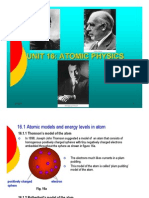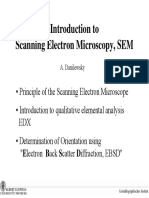Pin Aka Project
Pin Aka Project
Uploaded by
ErjieCopyright:
Available Formats
Pin Aka Project
Pin Aka Project
Uploaded by
ErjieOriginal Description:
Copyright
Available Formats
Share this document
Did you find this document useful?
Is this content inappropriate?
Copyright:
Available Formats
Pin Aka Project
Pin Aka Project
Uploaded by
ErjieCopyright:
Available Formats
Einsteinium, 99Es
General properties
Pronunciation /aɪnˈstaɪniəm/ (eyen-STY-nee-əm)
Appearance silvery; glows blue in the dark
Mass number 252 (most stable isotope)
Einsteinium in the periodic table
Atomic number (Z) 99
Group group n/a
Period period 7
Block f-block
Element category actinide
Electron configuration [Rn] 5f11 7s2
Electrons per shell 2, 8, 18, 32, 29, 8, 2
Physical properties
Phase at STP solid
Melting point 1133 K (860 °C, 1580 °F)
Boiling point 1269 K (996 °C, 1825 °F) (estimated)
Density (near r.t.) 8.84 g/cm3
Atomic properties
Oxidation states +2, +3, +4
Electronegativity Pauling scale: 1.3
1st: 619 kJ/mol
Ionization energies
Discovery of Einsteinium
Dr. Doug Stewart
Einsteinium was the seventh synthetic transuranium element of the actinide series to be
discovered.Einsteinium-253 (half-life 20.47 days) was identified in 1952 by teams of scientists from
the Lawrence Berkeley National Laboratory, the Argonne National Laboratory and the Los Alamos
Scientific Laboratory. The project was led by Albert Ghiorso .
Einsteinium was discovered unexpectedly along with fermium in debris from the first large
hydrogen bomb test, which took place in the Pacific on October 31 1952. The debris was collected
on filter papers attached to drone airplanes that flew through the explosion area. Later, to obtain
more material, many hundreds of pounds of coral from the blast area were examined. Einsteinium
was identified by chemical analysis. (1)
The new element was produced by the nuclear explosion in miniscule amounts by the
addition of 15 neutrons to uranium-238 (which then underwent seven beta decays). (2)
In 1961 einsteinium was produced in a weighable quantity (0.01 micrograms) for the first
(3)
time.
The pure metal was isolated for the first time in the 1970s. (3a)
The element is named after Albert Einstein.
History of Einsteinium
Einsteinium was discovered in the debris of the first thermonuclear explosion which took place on a
Pacific atoll, on 1 November 1952. Fall-out material, gathered from a neigbouring atoll, was sent to
Berkeley, California, for analysis. There it was examined by Gregory Choppin, Stanley Thompson, Albert
Ghiorso, and Bernard Harvey. Within a month they had discovered and identified 200 atoms of a new
element, einsteinium, but it was not revealed until 1955.
The einsteinium had formed when some uranium atoms had captured several neutrons and gone
through a series of capture and decay steps resulting in einsteinium-253, which has a half-life of 20.5 days.
By 1961, enough einsteinium had been collected to be visible to the naked eye, and weighed, although it
amounted to mere 10 millionths of a gram.
Appearance and Characteristics
Harmful effects: Einsteinium is harmful due to its radioactivity. Characteristics: Einsteinium is a
synthetic, highly radioactive metal that has only been produced in tiny amounts .It is the first
divalent metal in the actinide series (two bonding electrons rather than three). A radioactive metal,
only a few milligrams of which are made each year. The design is inspired by the work of Albert
Einstein and images collected from early particle accelerators, such as those at Cern and Fermilab
What is Einsteinium?
Einsteinium was discovered as a component of the debris of the first hydrogen bomb explosion
in 1952, and named after Albert Einstein. Its most common isotope einsteinium-253 (half-life 20.47
days) is produced artificially from decay of californium-253 in a few dedicated high-power nuclear
reactors with a total yield on the order of one milligram per year. The reactor synthesis is followed by
a complex process of separating einsteinium-253 from other actinides and products of their decay.
Other isotopes are synthesized in various laboratories, but at much smaller amounts, by bombarding
heavy actinide elements with light ions. Owing to the small amounts of produced einsteinium and the
short half-life of its most easily produced isotope, there are currently almost no practical applications
for it outside basic scientific research. In particular, einsteinium was used to synthesize, for the first
time, 17 atoms of the new element mendelevium in 1955.
Einsteinium is a soft, silvery, paramagnetic metal. Its chemistry is typical of the late actinides, with a
preponderance of the +3 oxidation state; the +2 oxidation state is also accessible, especially in solids.
The high radioactivity of einsteinium-253 produces a visible glow and rapidly damages its crystalline
metal lattice, with released heat of about 1000 watts per gram. Difficulty in studying its properties is
due to einsteinium-253's decay to berkelium-249 and then californium-249 at a rate of about 3% per
day. The isotope of einsteinium with the longest half-life, einsteinium-252 (half-life 471.7 days)
would be more suitable for investigation of physical properties, but it has proven far more difficult to
produce and is available only in minute quantities, and not in bulk.[1] Einsteinium is the element with
the highest atomic number which has been observed in macroscopic quantities in its pure form, and
this was the common short-lived isotope einsteinium-253.[2]
Like all synthetic transuranic elements, isotopes of einsteinium are very radioactive and are
considered highly dangerous to health on ingestion.[3]
Timeline Discovery of Einsteinium
Einsteinium was discovered
unexpectedly along with fermium in debris
from the first large hydrogen bomb test, which
1952 took place in the Pacific on October 31 1952.
The debris was collected on filter papers
attached to drone airplanes that flew through
the explosion area.
Einsteinium was produced in a
1961 weighable quantity (0.01 micrograms) for the
first time.
The pure metal was isolated for the
first time
1970
You might also like
- Solution Manual Chemistry, An Atoms First Approach 3rd Edition by ZumdahlNo ratings yetSolution Manual Chemistry, An Atoms First Approach 3rd Edition by Zumdahl18 pages
- Raman Spectroscopy of Carbon TetrachlorideNo ratings yetRaman Spectroscopy of Carbon Tetrachloride8 pages
- Einsteinium - Es: Chemical Properties of Einsteinium Health Effects of Einstenium Environmental Effects of EinsteiniumNo ratings yetEinsteinium - Es: Chemical Properties of Einsteinium Health Effects of Einstenium Environmental Effects of Einsteinium2 pages
- 204068Instant download (Ebook) Encyclopedia of Inorganic Chemistry in 10 Vol. 2 ed. by King R. Bruce ISBN 9780470860786, 0470860782 pdf all chapter100% (1)204068Instant download (Ebook) Encyclopedia of Inorganic Chemistry in 10 Vol. 2 ed. by King R. Bruce ISBN 9780470860786, 0470860782 pdf all chapter76 pages
- Encyclopedia of Inorganic Chemistry in 10 Vol 2 ed 2nd Edition King R. Bruce All Chapters Instant Download100% (4)Encyclopedia of Inorganic Chemistry in 10 Vol 2 ed 2nd Edition King R. Bruce All Chapters Instant Download50 pages
- Instant download Encyclopedia of Inorganic Chemistry in 10 Vol 2 ed 2nd Edition King R. Bruce pdf all chapter100% (2)Instant download Encyclopedia of Inorganic Chemistry in 10 Vol 2 ed 2nd Edition King R. Bruce pdf all chapter51 pages
- Buy ebook Encyclopedia of Inorganic Chemistry in 10 Vol 2 ed 2nd Edition King R. Bruce cheap price100% (2)Buy ebook Encyclopedia of Inorganic Chemistry in 10 Vol 2 ed 2nd Edition King R. Bruce cheap price50 pages
- 5.3-6 Dominique Greneche - A Nuclear Reactor How It WorksNo ratings yet5.3-6 Dominique Greneche - A Nuclear Reactor How It Works79 pages
- Lesson 3 - Synthesis of Elements in The Laboratory100% (3)Lesson 3 - Synthesis of Elements in The Laboratory62 pages
- Artifical Radioactivity Produced by Neutron Bombardment: Nobel Lecture, December 12, 1938No ratings yetArtifical Radioactivity Produced by Neutron Bombardment: Nobel Lecture, December 12, 19388 pages
- ATOMS Science 8 Prepared by Ma'am EllieNo ratings yetATOMS Science 8 Prepared by Ma'am Ellie58 pages
- Nuclear Physics: Files Without This Message by Purchasing Novapdf PrinterNo ratings yetNuclear Physics: Files Without This Message by Purchasing Novapdf Printer3 pages
- Gordon Edwards PH.D.: Speaker's Notes For The Nunavut Planning CommissionNo ratings yetGordon Edwards PH.D.: Speaker's Notes For The Nunavut Planning Commission11 pages
- Structure of An Atom and The Periodic TableNo ratings yetStructure of An Atom and The Periodic Table2 pages
- Chapter 2 - Physci - Atoms in The Eyes of Philosophers and Scientists50% (2)Chapter 2 - Physci - Atoms in The Eyes of Philosophers and Scientists34 pages
- A Brief History of Element Discovery, Synthesis, and AnalysisFrom EverandA Brief History of Element Discovery, Synthesis, and AnalysisNo ratings yet
- Chapter 3 - Chemical Bonding - ExercisesNo ratings yetChapter 3 - Chemical Bonding - Exercises6 pages
- Lesson Plan-Q3M5 (Electronic Configurations)No ratings yetLesson Plan-Q3M5 (Electronic Configurations)4 pages
- Introduction To Scanning Electron Microscopy, SEMNo ratings yetIntroduction To Scanning Electron Microscopy, SEM24 pages
- Physics Note Atomic Model and Nuclear PhysicsNo ratings yetPhysics Note Atomic Model and Nuclear Physics26 pages
- Physical Science 11 q1 Module 2 08082020No ratings yetPhysical Science 11 q1 Module 2 0808202027 pages
- FLS1000 Photoluminescence Spectrometer BrochureNo ratings yetFLS1000 Photoluminescence Spectrometer Brochure24 pages
- Solution Manual Chemistry, An Atoms First Approach 3rd Edition by ZumdahlSolution Manual Chemistry, An Atoms First Approach 3rd Edition by Zumdahl
- Einsteinium - Es: Chemical Properties of Einsteinium Health Effects of Einstenium Environmental Effects of EinsteiniumEinsteinium - Es: Chemical Properties of Einsteinium Health Effects of Einstenium Environmental Effects of Einsteinium
- 204068Instant download (Ebook) Encyclopedia of Inorganic Chemistry in 10 Vol. 2 ed. by King R. Bruce ISBN 9780470860786, 0470860782 pdf all chapter204068Instant download (Ebook) Encyclopedia of Inorganic Chemistry in 10 Vol. 2 ed. by King R. Bruce ISBN 9780470860786, 0470860782 pdf all chapter
- Encyclopedia of Inorganic Chemistry in 10 Vol 2 ed 2nd Edition King R. Bruce All Chapters Instant DownloadEncyclopedia of Inorganic Chemistry in 10 Vol 2 ed 2nd Edition King R. Bruce All Chapters Instant Download
- Instant download Encyclopedia of Inorganic Chemistry in 10 Vol 2 ed 2nd Edition King R. Bruce pdf all chapterInstant download Encyclopedia of Inorganic Chemistry in 10 Vol 2 ed 2nd Edition King R. Bruce pdf all chapter
- Buy ebook Encyclopedia of Inorganic Chemistry in 10 Vol 2 ed 2nd Edition King R. Bruce cheap priceBuy ebook Encyclopedia of Inorganic Chemistry in 10 Vol 2 ed 2nd Edition King R. Bruce cheap price
- 5.3-6 Dominique Greneche - A Nuclear Reactor How It Works5.3-6 Dominique Greneche - A Nuclear Reactor How It Works
- Lesson 3 - Synthesis of Elements in The LaboratoryLesson 3 - Synthesis of Elements in The Laboratory
- Artifical Radioactivity Produced by Neutron Bombardment: Nobel Lecture, December 12, 1938Artifical Radioactivity Produced by Neutron Bombardment: Nobel Lecture, December 12, 1938
- Nuclear Physics: Files Without This Message by Purchasing Novapdf PrinterNuclear Physics: Files Without This Message by Purchasing Novapdf Printer
- Gordon Edwards PH.D.: Speaker's Notes For The Nunavut Planning CommissionGordon Edwards PH.D.: Speaker's Notes For The Nunavut Planning Commission
- Chapter 2 - Physci - Atoms in The Eyes of Philosophers and ScientistsChapter 2 - Physci - Atoms in The Eyes of Philosophers and Scientists
- Summary of Sam Kean's The Disappearing SpoonFrom EverandSummary of Sam Kean's The Disappearing Spoon
- A Brief History of Element Discovery, Synthesis, and AnalysisFrom EverandA Brief History of Element Discovery, Synthesis, and Analysis

























































































